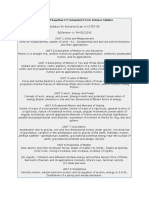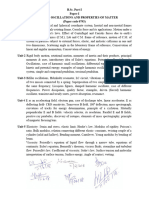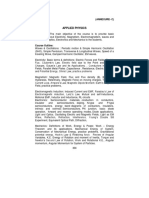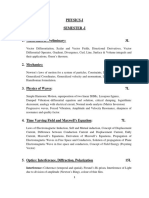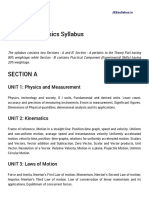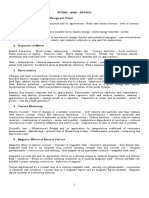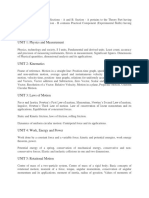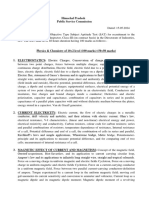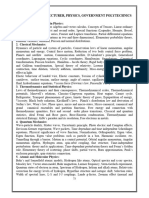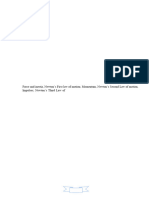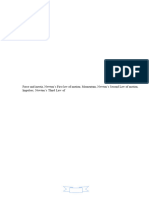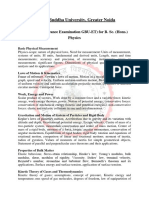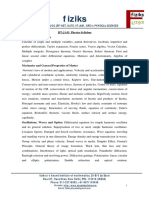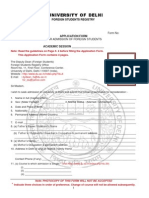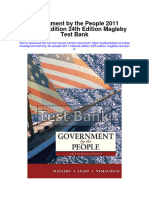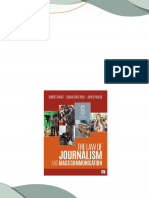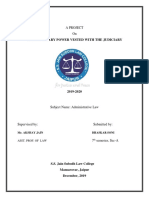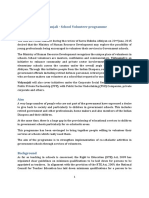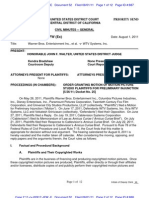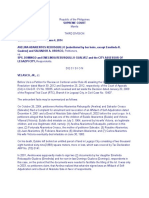Physics Syllabus
Physics Syllabus
Uploaded by
DeepakSinghCopyright:
Available Formats
Physics Syllabus
Physics Syllabus
Uploaded by
DeepakSinghOriginal Description:
Original Title
Copyright
Available Formats
Share this document
Did you find this document useful?
Is this content inappropriate?
Copyright:
Available Formats
Physics Syllabus
Physics Syllabus
Uploaded by
DeepakSinghCopyright:
Available Formats
1/1/07
Untitled Document
Department of Physics and Electronics
B.Sc. (Physics)
(Sem I)
Paper 1: (P101) MECHANICS and WAVE MOTION
Unit I
Frames of Reference- Frame of Reference, Inertial Frames of Reference, Non Inertial Frames and Fictitious Force,
Centrifugal Force, Rotating Frame of Reference. Dynamics of particle in rectilinear and circular
motion
Conservation of Energy Conservation of Laws, Work Energy Theorem, Conservative Forces, Linear Restoring Force,
Non-Conservative Forces, Motion under Friction, Inclined Plane, Motion in a Vertical
Circle.
Linear And Angular Momentum- Conservation of Linear Momentum, Center of Mass, Collision in 2D , Impact, Angular
Momentum And Torque.
Unit II
Potential and Fields- Central forces , Inverse Square-Law force, Gravitational Field and Potential, Equipotential Surface,
Velocity of Escape, Satellite in Circular Orbit, Gravitational field and Potential due to a thin Spherical Shell, Potential and
Field due to a Solid Sphere, Keplers Laws, Newtons Deduction from Keplers
Laws
Harmonic Oscillator- Differential equation of Simple Harmonic Motion (SHM) and its solution, Energy of Harmonic
Oscillator(HO), Examples of HO.
Unit III
Composition of Two SHMs, Lissajous Figures.
Damped and Forced Harmonic Oscillator- Damping Force, Damped Harmonic Oscillator, Driven or Forced harmonic
oscillator, Sharpness of Resonance, Velocity and Amplitude Resonance.
Wave Motion- Differential Equation of Wave Motion, Plane Progressive Harmonic Waves in fluid media, Principle of
superposition, Energy density of Plane Progressive wave, Particle and Wave Velocity, Longitudinal waves in GasesPressure variations for plane waves, Waves in Linear bounded medium, Stationary wave solution, Flow of Energy in
Stationary Waves
Unit IV
Dynamics of Rigid Bodies- Equation of Motion for a Rotating Rigid Body, Angular Momentum and Moment of Inertia,
Inertia Tensor, Theorems on Moment of Inertia, Calculation of Moment of inertia of Bodies of Different Shapes, Kinetic
Energy of Rotating Body
Elasticity- Stress, Strain, Hooks Law, Youngs Modulus , Bulk Modulus and Modulus of Rigidity or Shear modulus ,
Poissons Ratio, Relation Connecting Various Elastic constants, Angle of Twist and Angle of Shear, Twisting Couple on a
Cylindrical Rod or Wire, Bending of Beams, Bending Moment, Beam supported at is ends and Loaded in the Middle.
Books Recommended
1. Physics IResnick & Halliday (J. Wiley and Sons (SEA) PTE Ltd.
2. Mechanics D.S. Mathur (S.Chand and Company Ltd.)
3. Elements of mechanics J. C. Upadhyay (S.Chand and Company Ltd)
file:///E:/wwwroot/syllabus backup/phy.html
1/8
1/1/07
Untitled Document
Paper 2: (P102) Circuit Fundamental and Basics Electronics
Unit I
Growth and Decay of Currents Through Inductive Resistance,Charging and Discharging in RC and L.C.R. Circuit, Time
Constant
Measurement of High Resistance, A.C. bridges, Maxwells and Scheringes Bridges, Wien Bridge.
Unit II
Semiconductors, Intrinsic and Extrinsic, n-type, p-type Semiconductors
Unbiased Diodes,Diode as a rectifier, Forward Reversed Biased Diodes, Diode Characteristics, Zener Diode, Avalanche
and Zener Breakdown, power supplies: Rectifier, bridge rectifier, capacitor input Filter, voltage regulator, Zener
regulator.
Bipolar Transistors, Three Doped Regions- Forward and Reverse Bias, D.C. alpha, D.C. beta, Transistor
Curves.
Unit III
Transistor Biasing Circuits, Emitter Bias, Base bias, Voltage Divider Bias, D.C. load line
Basic AC Equivalent Circuits, Low frequency model, small signal amplifiers, Common Emitter Amplifier, common
collector amplifier, common base amplifier Current and Voltage Gain, RC coupled amplifier-qualitative treatment only.
Frequency response, input and output impedances,
Feedback
Principles
Unit IV
Transistor as an Oscillator-General Discussion and Theory of Hartely Oscillator
Elements of Transmission and Reception, Basic Principles of Amplitude Modulation
and Demodulation
Principle and Design of Linear Millimeters and Their Application, Cathode Ray
Oscillograph and its Simple Applications
Recommended Books
1. Principles of Electronices- V.K.Mehta (S.Chand publications)
2. Circuit Fundamentals and Basics- J.P.Agarwal (pragati prakashan, Meerut)
(Sem II)
Paper 1: (P201) Optics
Unit I
Condition for Observing Interference, Visibility of Fringes, Production of Coherent Sources , Temporal and Spatial
Coherence Production Interference Fringes and Determination of Wavelength,
Biprism
Production of Achromatic Fringes, Colour of Thin films, Newton Rings.
Multiple Reflection, Fabry Perot Interferometer and LG plate, Filter.
Unit II
file:///E:/wwwroot/syllabus backup/phy.html
2/8
1/1/07
Untitled Document
Fresnels diffraction, Fresnels zones and propagation of light, zone plate, Fresnels diffraction at edge and narrow wire.
Fraunhofer diffraction at multiple slits, limiting cases- single and double
slits.
Unit III
Polarization, Double Refraction in Uniaxial Crystals, Huygens Theory of Double
Refraction.
Nicole Prism, Polaroids and Retardation Plates, Half and Quarter Wave Plates , Production and Detection of Elliptically
Polarisied Light.
Optical Activity, Fresnels Theory of Optical Rotation, Matrix Representation of Plane Polarized Waves, Matrices of
Polarizer Retardation and Rotation . Application to Simple Systems, Light
Sources.
Unit IV
Resolving power-criterion, expressions for resolving powers of telescope, grating.
Optical instruments- Spectrometer, Michelson Interferometer, Sextant, Babinets compensator, Half Shade and Biquartz,
Polarimeter.
Recommended Books
1. Fundamentals of Optics-A.Jenkins and H.E.White (Mc Graw Hill International Book Company)
2. A Text Book of Optics Brij Lal and Subramanyam (S.Chand and Company Ltd.)
Paper 2: Experiments (P202)
1.
2.
3.
4.
5.
6.
7.
8.
9.
10.
11.
12.
13.
Determination of modulus of Rigidity of the Material of a Wire by the Statistical Method.
Determination of Youngs modulus of the Material of a Bar by Flexure Method.
Determination of Coefficient of Viscosity of Water.
Determination of Surface Tension of Water by Capillary rise Method.
Measurement of height with a sextant.
Determination of wavelength of Sodium light by Newtons rings.
Determination of specific rotation of an optically active substance by polarimeter.
Verification of Brewsters law.
Determination of Acceleration due to Gravity by Compound Pendulum.
Determination of frequency of a.c. mains with the help of sonometer.
Determination of resolving power of telescope.
Determination of diameter of wire by diffraction.
Measurement of dispersive power of a prism.
(Sem. III)
Paper 1: P(301) Electricity and Magnetism
Unit-I (Electrostatics)
Coulombs Law, Electric Field and Potential, Field due to Uniformly Charged Sphere, Poisson and Laplace Equation,
Gauss law and its application: The field of a conductor, Electric Dipole, Field and Potential due to Electric Dipole, Dipole
Approximation for an arbitrary charge distribution, Electric Quadrupole, Field due to Electric Quadrupole, Electrostatic
Energy of a uniformly charged sphere, Energy of a condenser.
file:///E:/wwwroot/syllabus backup/phy.html
3/8
1/1/07
Untitled Document
Unit-II (Magnetostatics)
Magnetic Field, Magnetic Force of a current, Magnetic Induction, Biot-Savart Law, Lorentz force, Vector and Scalar
Magnetic Potential, Magnetic Dipole, Magnetomotive Force, Amperes Circuital Theorem and its applications: magnetic
field due to a wire carrying current and solenoid.
Unit-III (Electromagnetic Induction)
Laws of induction, Faradays law and Lenz Law,
Mutual and Self Induction, Vector Potential in varying Magnetic Field, Skin Effect, Motion of Electron in changing
magnetic field, Magnetic energy in a field, induced magnetic field, Displacement current, Maxwells Equation, Poynting
Vector, Electromagnetic Waves in Free space, Theory and working of ballistic Galvanometer
Unit-IV (Magnetic Properties of Matter)
Intensity of Magnetization and magnetic susceptibility, Properties of Dia, Para and Ferromagnetic materials, Curie
Temperature, Hysteresis and its experimental determination.
Dielectrics, Dielectric constant, polarization, electronic, atomic or ionic polarization, polarization charges, Electrostatic
equations, Field, Force and Energy in Dielectrics, Debye Model.
Books recommended
1. Electricity, Magnetism and Electronics- Ahmad and Lal(Unitech House, Lko.)
2. Electricity and Magnetism- K. K. Tiwari (S. Chand and Company Ltd.)
(P302)List of experiments
1.
2.
3.
4.
5.
6.
7.
8.
9.
10.
11.
To Study Time constant in CR Circuit.
To study Solid State Common Power Supply.
To determine the capacity of condenser by absolute method.
To determine the coefficient of mutual induction between two coils.
To determine the coefficient of self inductance.
To study the characteristics of pnp transistor.
To study the characteristics of junction of diode.
To study the characteristics of Zener diode.
To study LCR circuit.
To calibrate an oscillator using CRO.
To find the values of Stefans constant.
(Sem. IV)
Paper 1: P(401) Thermal Physics
Unit-I
Thermal equilibrium, Zeros law of Thermodynamics, Temperature concept, Equation of State, Vander walls Equation,
Critical Constants, Principle of corresponding States
Unit-II
First law of thermodynamics, Absolute scale of temperature, Entropy, Degradation of Energy, Enthalpy, Helmholtz
function, Gibbs function, Maxwells Thermodynamic relations and their applications.
Unit-III
Differential and Integral Joule Thomson Effect, Inversion Temperature, Liquification of gases (no experimental details),
file:///E:/wwwroot/syllabus backup/phy.html
4/8
1/1/07
Untitled Document
Adiabatic Demagnetization HeI and HeII, Clausius-Clapeyrons equation.
Unit-IV
Kinetic Theory, Maxwell-Boltzmann Law, Equipartition of energy, mean free path, Transport phenomenon, Brownian
motion, Avagadro number, Thermodynamic and Kinetic Temperature, Black Body radiation, Stefan Boltzmann law,
Plancks law and its verification
Books Recommended
1. Thermal Physics- B.K.Agarwal (LokBharti Publication)
2. Heat, Thermodynamics and Statistical Physics - BrijLal & Subramanyam (S.Chand and Company Ltd)
(Sem. IV)
Paper 2: P(402) Elements of Quantum Mechanics and Atomic Spectra
Unit-I
Inadequacies of Quantum Mechanics, Photoelectric Phenomenon, Compton effect, Wave particle Duality, de broglie
matter wave and their experimental determination, Heisenbergs uncertainty Principle, Complementary principle, Principle
of superposition, motion of wave packets.
Unit-II
Schrdinger wave equation, Interpretation of wave function, expectation values of dynamic variables, Ehrenfest
theorem,orthonormal properties of wave function, one dimensional motion in step potential, rectangular barrier, Square
well potential, particle in a box, normalization.
Unit-III
Bohr atomic model, Sommerfeld Elliptic orbits, Spin and orbital magnetic moments, Stern Gerlach experiment, Paulis
exclusion Principle and periodic table, Optical Spectra of Alkali and Alkaline earth elements, Fine structure of Spectral
lines, Coupling Schemes(LS and JJ) for two electron systems.
Unit-IV
Normal and Anomalous Zeeman Effect and Paschen Back Effect of one Electron Systems, Experimental Observations,
X-ray Spectra- continuous and characteristic, their generation and uses, Spin and Screening Doublets.
Books Recommended
1. Concepts of modern physics- A.Beiser (TATA Mc Graw Hill)
2. Modern Physics-R.Murugeshan & K.Sivaprastha ( S.Chand and Company Ltd)
(Sem.V)
Paper 1: P(501) Electronics
Unit-I (network theorems and circuit analysis)
Thevenin, Norton and superposition theorems and their applications- T and Network characteristic Interactive and image
impedances, constant K and Derived m type filters, transmission lines, Characteristic impedances and Attenuations,
file:///E:/wwwroot/syllabus backup/phy.html
5/8
1/1/07
Untitled Document
Reflection Coefficients,
Diodes,Diffusion of minority carrier in semiconductor, work function in metals and semiconductors, junction between
metals and semiconductors, semiconductor and semiconductor, p-n junction, depletion layer , junction potential, width of
depletion layer, field and capacitance of depletion layer, forward ac and dc resistance of junction, reverse breakdown.
Unit-II (diodes)
Zener and Avalanche diode, tunnel diode, point contact diode, their importance at high frequencies, LED, Photodiodes,
Effect of temperature on junction diode thermistors.
(Transistors)Transistor parameters, Base width modulation, transit time and life time of minority carriers, base and emitter
resistance, collector conductance, base spreading resistance, diffusion capacitance, reverse feedback ratio, Equivalent
Circuit for Transistors, Basic model, Hybrid Model and Y-parameter equivalent circuit, input and output impedances.
Unit-III
Current and voltage gain, biasing formula for transistors, base bias, emitter bias and mixed type bias, biasing for small and
large signal operation.Transistor circuit, application at low frequencies, their ac and dc equivalent for three different modes
of operation, large signal operation of transistor, heat sink, thermal resistance, distortion in amplifiers, cascading of stage,
frequency response, negative and positive feedback in transistor amplifier.
Unit-IV
FET, characteristics, biasing of FET, use in preamplifiers, MOSFET and their uses. Power Supplies- Electronically
regulated low and high voltage power supplies, invertors for battery operated equipments.
Miscellaneous basic linear integrated circuits, photo transistors, silicon controlled rectifiers, UJT and their simple uses.
Books Recommended
1. Electrical Technology, Vol IV-B.L. Thareja(S.Chand and Company Ltd)
2. Networking Analysis-J.Ryder ( )
3. Circuit Fundamental and basic Electonics- J.P.Agarwal(Pragati Prakashan, Meerut)
Paper 2: (P502) Solid State Physics
Unit I (Crystal Structure)
Lattice translation vectors and lattice, Symmetry operation, Basis and crystal structures, Symmetry operation, basis and
crystal structure, Primitive lattice cell, two-dimensional lattice system, Number of lattice, Point groups and plane groups
Three dimensional lattice types system no. of lattices, Point groups and space groups.Index system for crystal plane miller
indices, Simple crystal structures. NaCl, CsCl, hcp diamond, cubic ZnS and hexa. ZnS. Occurrence of nonideal crystal
structures,Random stacking of polytypism glasses.
UnitII(Crystal diffraction and reciprocal lattice)
Incident beam, Braggs law, Experimental diffraction method. Laue method Rotating crystal method, Powder method.
Derivation of scattered wave amplitude, Fourier analysis, Reciprocal lattice vectors diffraction condition Ewald method
Brillouin zones, reciprocal lattice to sc, bcc and fcc lattice, Fourier analysis of the basis and atomic form factor.
Unit III (Crystal Bindings)
Crystals of inert gases, Vander walls-London interaction-Repulsive interaction, Equilibrium lattice constants, cohesive
energy, Compressibility and bulk modulus, Ionic crystal, modelung energy, Evaluation of modelung constants, covalent
crystals, Hydrogen bonding crystals, Atomic crystals, Atomic radii, Lattice heat capacity, Einstein model, Variation of
file:///E:/wwwroot/syllabus backup/phy.html
6/8
1/1/07
Untitled Document
mono-atomic lattice.
Unit IV (Lattice vibrations)
Derivation of dispersion relation, First Brillion zones , group velocity, continuum limit, Force constant, Lattice with two
atoms per primitive cell, Derivation of dispersion relation, Acoustic and optical modes, phonon momentum, Free electron
theory, Fermi energy, Density of states, Heat energy of electron gas, Paramagnetic susceptibility of conduction electron,
Hall effect in metals.
Origin of band theory, Quantitative idea of Bloch Theorem, Kronig Penny Model, number of orbital in a band conductor
and insulators, effective mass, concept of holes.
(Sem. VI)
Paper 1: P(601) Elements of Relativistic, Classical and Statistical Mechanics
Unit-I (Relativistic Mechanics)
Earth as a reference frame, Galilean transformation, Michelson Morley Experiment, Postulates of Special Theory of
Relativity, Lorentz transformations, Length Contraction and Time Dilation, Law of Addition of velocities, Variation of mass
with velocity, Principle of Equivalance of mass and Energy.
Unit-II (Classical mechanics)
Mechanics of a system of particles, generalized coordinates, DAlemberts Principle, Lagrangean Formulation and
Lagranges Equation of motion, Calculus of Variation and its Apllication. Hamiltonian formulation and Hamiltons equation
of motion.
Unit-III (Classical and Statistical mechanics)
The Rigid Body motion, Force free motion of symmetrical rigid body. Two body Central Force problem, reduction to
equivalent one body problem, The equation of motion and First Integrals, Classification of orbits, orbit for integral powerlaw potentials, Inverse square- law , Keplers problem, Inadequacies of Classical mechanics, phase space, Liouvilles
theorem, connection between statistical and thermodynamic quantities.
Unit-IV (Statistical Mechanics)
Ensembles, the microcanonical, the canonical and the grand canonical Ensembles, Maxwell-Boltzmann statistics, Partition
function , Maxwell velocity distribution and mean values, equipartition theorem, statistics of interacting system, Vander
Walls gas, Electron gas and Plancks oscillator.
Books Recommended
1. Special Relativity- A.P.French( Norton)
2. Classical Mechanics- H.Goldstein(Narosa Publishing house)
3. Statistical Mechanics- B.K.Agarwal & Melvin Eisner (New Age International Publication)
Paper 2: (P602) Nuclear Physics
Unit-I (General Properties of Nucleus)
Brief survey of general properties of the nucleus, mass defect and binding energy, charge, size, spin and magnetic
moment, Brainbridge mass spectrograph.
file:///E:/wwwroot/syllabus backup/phy.html
7/8
1/1/07
Untitled Document
Nuclear Model
Liquid Drop Model and Bieth-Weizacher mass formula, Single Particle Shell model
Unit II
Nuclear Force
Saturation phenomenon and exchange force, Deutron ground State properties.
Natural Radioactivity
Fundamental laws of radioactivity, Soddy-Fajans Displacement law of radioactive disintegration, basic idea about ,
and decay.
Unit-III (Nuclear Reactions)
Nuclear reactions and their conservation laws, cross section of nuclear reactions, theory of fission, Nuclear reactors and
nuclear fusion.
Elementary Particles
Basic classification based on rest mass, spin and half life, particle interactions (gravitational, electromagnetic, weak and
strong interactions.
Unit IV
Accelerators and detectors
Vande Graff Cyclotron, Synchrotron, Interaction of charged particles and Gamma Rays with Matter, G M Counter,
Scintillation Counter and Neutron Detectors
Books Recommended
1.
2.
3.
4.
Nuclear Physics-S.N.Ghoshal (S.Chand and Company Ltd)
Nuclear Physics-An Introduction- S.B.Patel (New Age International ltd.)
Solid State Physics- S.O.Pillai(New Age Publication)
Solid State Physics-Kittel (Wiley)
file:///E:/wwwroot/syllabus backup/phy.html
8/8
You might also like
- Technical Standard Order: TSO-C39cDocument6 pagesTechnical Standard Order: TSO-C39cthreshold71100% (1)
- Department of Physics and Electronics B.Sc. (Physics)Document12 pagesDepartment of Physics and Electronics B.Sc. (Physics)621 605ManishNo ratings yet
- BSC Syllabus PhysicsDocument9 pagesBSC Syllabus PhysicsMax TNo ratings yet
- Syllabus of Engineering Physics Paper:Physics-1 (Phy-101) (B.Tech-I Sem All Branches)Document2 pagesSyllabus of Engineering Physics Paper:Physics-1 (Phy-101) (B.Tech-I Sem All Branches)Aishwarya SharmaNo ratings yet
- University of Rajasthan CCT Integrated MDocument13 pagesUniversity of Rajasthan CCT Integrated Mjain_akshi_29No ratings yet
- 1C8BDF22-8FED-4D2C-B109-810BF969E936Document6 pages1C8BDF22-8FED-4D2C-B109-810BF969E936ashvinilata2002No ratings yet
- 214 PhysicsDocument5 pages214 PhysicsezakbelachewNo ratings yet
- ComprehensiveCourses Syllabus Nov2017Document2 pagesComprehensiveCourses Syllabus Nov2017Chitra DolaiNo ratings yet
- PhysicsDocument5 pagesPhysicsamazon audibleNo ratings yet
- Physics I ST Grade 12122013Document6 pagesPhysics I ST Grade 12122013mittalnipun2009No ratings yet
- NTA CUET UG 2022 Science Domain (Physics, Chemistry, Mathematics, Biology) Solved Papers (YCT Expert Team) (Z-Library)Document56 pagesNTA CUET UG 2022 Science Domain (Physics, Chemistry, Mathematics, Biology) Solved Papers (YCT Expert Team) (Z-Library)vishwakarmasurendra415No ratings yet
- B.Sc. Part-I Paper-I Mechanics, Oscillations and Properties of Matter (Paper Code 0793)Document17 pagesB.Sc. Part-I Paper-I Mechanics, Oscillations and Properties of Matter (Paper Code 0793)playergghazlian173No ratings yet
- Applied Physics NTCDocument2 pagesApplied Physics NTCFasih Khan DurraniNo ratings yet
- NEET Syllabus Class XIIDocument13 pagesNEET Syllabus Class XIIStudyVidya.com100% (2)
- Syllabus (2020) : CSIR-NET Physical SciencesDocument12 pagesSyllabus (2020) : CSIR-NET Physical SciencesJaymin RayNo ratings yet
- Joint Entrance Examination (Main) - 2023: PhysicsDocument5 pagesJoint Entrance Examination (Main) - 2023: PhysicsLakshya SinghiNo ratings yet
- Microsoft Word - B.sc. Physics SllybusDocument3 pagesMicrosoft Word - B.sc. Physics SllybusRahul YadavNo ratings yet
- PHYSICS NEETDocument6 pagesPHYSICS NEETsampadmishra1950No ratings yet
- Engg-Phys Course NITADocument4 pagesEngg-Phys Course NITAAkash KumarNo ratings yet
- Physics (Code No. 06)Document2 pagesPhysics (Code No. 06)Gourang PaulNo ratings yet
- PhysicsDocument3 pagesPhysicscontender07No ratings yet
- AIPMT Syllabus 2012Document18 pagesAIPMT Syllabus 2012Amit KumarNo ratings yet
- JEE (Main) Physics Syllabus: UNIT 1: Physics and MeasurementDocument7 pagesJEE (Main) Physics Syllabus: UNIT 1: Physics and Measurementmajji satishNo ratings yet
- Physics: Syllabus For B.Tech. (4years) / Biotechnology-Dual Degree (B.Tech / M.Tech) & B.SC - NursingDocument11 pagesPhysics: Syllabus For B.Tech. (4years) / Biotechnology-Dual Degree (B.Tech / M.Tech) & B.SC - NursingARYAN RATHORENo ratings yet
- UNIT 1: Physics and MeasurementDocument5 pagesUNIT 1: Physics and Measurementapi-357657147No ratings yet
- Syllabus For KalingaDocument9 pagesSyllabus For Kalingaprakhar.soni.1905No ratings yet
- JU EE SyllabusDocument45 pagesJU EE Syllabusmenilanjan89nLNo ratings yet
- NEET 2024 Physics Revised SyllabusDocument6 pagesNEET 2024 Physics Revised Syllabusvaidsakshi43No ratings yet
- Viteee - 2020 - Physics 1. Laws of Motion & Work, Energy and PowerDocument2 pagesViteee - 2020 - Physics 1. Laws of Motion & Work, Energy and PowerAaditya KannanNo ratings yet
- A.P. State Eligibility Test - 2012: Physical SciencesDocument3 pagesA.P. State Eligibility Test - 2012: Physical SciencesSashil ReddyNo ratings yet
- Sem II SyllabusDocument8 pagesSem II Syllabusgurucharanmurmu904No ratings yet
- B. Sc. Part - I Physics 2013 PDFDocument5 pagesB. Sc. Part - I Physics 2013 PDFRANDOLPHENo ratings yet
- Section - A Unit 1: Physics and MeasurementDocument5 pagesSection - A Unit 1: Physics and MeasurementAbin VargheseNo ratings yet
- Physics Syllabus For Jee Mains 2018Document5 pagesPhysics Syllabus For Jee Mains 2018Addhyan TiwariNo ratings yet
- Physics - Pastpaper For CssDocument12 pagesPhysics - Pastpaper For Cssdanyalhaider222333No ratings yet
- 0 Physics SyllabusDocument2 pages0 Physics Syllabusiffat fatima patilNo ratings yet
- PhysicsDocument4 pagesPhysicsLakshay DubeyNo ratings yet
- 5 6206075370165243477Document6 pages5 6206075370165243477pratiyaum98No ratings yet
- Physics Syllabus UKPSCDocument3 pagesPhysics Syllabus UKPSCBiswajeet MishraNo ratings yet
- SAEEE Physics SyllabusDocument4 pagesSAEEE Physics Syllabusanujars5410% (1)
- Syllabus B.Tech, B.Des and Under Graduate Programs in Health SciencesDocument11 pagesSyllabus B.Tech, B.Des and Under Graduate Programs in Health SciencesChakradhar DNo ratings yet
- Physics12th08 02 2018Document48 pagesPhysics12th08 02 2018Priyanga V SNo ratings yet
- Neetu g 2025Document10 pagesNeetu g 2025humaap200025No ratings yet
- neetUG2025_removedDocument15 pagesneetUG2025_removedumarsvvbastiNo ratings yet
- UV03Document4 pagesUV03divyanshkumar3112No ratings yet
- Oavs PGTPhysicsDocument5 pagesOavs PGTPhysicsPragyan GiriNo ratings yet
- Physics Syllabus For Main ExaminationDocument8 pagesPhysics Syllabus For Main ExaminationsarfarajansariNo ratings yet
- Engineering Physics NotesDocument242 pagesEngineering Physics NotesPRASHANTH REDDY MUNGINo ratings yet
- PhysicsDocument4 pagesPhysicsAbhinave SNo ratings yet
- Physics 322Document4 pagesPhysics 322dubeyalokkumar2005No ratings yet
- Syllabus Quantum MechanicsDocument7 pagesSyllabus Quantum MechanicsRidika Chaturvedi100% (2)
- Computer Programming II: Text and Reference BooksDocument6 pagesComputer Programming II: Text and Reference BooksAdarshNo ratings yet
- Syll Phy 12 17 05 2024Document5 pagesSyll Phy 12 17 05 2024aniketvideosytNo ratings yet
- Physics Syllabus For JEE Mains & AdvancedDocument7 pagesPhysics Syllabus For JEE Mains & AdvancedPradeep BeniwalNo ratings yet
- Fiziks: IIT-JAM Physics Syllabus Mathematical MethodsDocument3 pagesFiziks: IIT-JAM Physics Syllabus Mathematical MethodsBhuvnesh TenguriaNo ratings yet
- Physical Science SET SyllabusDocument4 pagesPhysical Science SET SyllabusNitinNo ratings yet
- Rajasthan Public Service Commission, Ajmer: Syllabi of The Paper/Subjects Prescribed For The Main ExaminationDocument2 pagesRajasthan Public Service Commission, Ajmer: Syllabi of The Paper/Subjects Prescribed For The Main ExaminationSignificanceclasses GgnNo ratings yet
- Elementary Particle Physics in a NutshellFrom EverandElementary Particle Physics in a NutshellRating: 4.5 out of 5 stars4.5/5 (3)
- Choa Vs People PDFDocument6 pagesChoa Vs People PDFstrgrlNo ratings yet
- Contracts Project SynopsisDocument7 pagesContracts Project SynopsisDisha LohiyaNo ratings yet
- Sec 17 of Indian Registration ActDocument5 pagesSec 17 of Indian Registration ActVivek ReddyNo ratings yet
- Eulogia Inn LLP GST CertificateDocument3 pagesEulogia Inn LLP GST CertificateKavit ThakkarNo ratings yet
- Application Form: Form No: For Admission of Foreign StudentsDocument4 pagesApplication Form: Form No: For Admission of Foreign StudentsdapineyNo ratings yet
- Golden Ribbon v. City of ButuanDocument8 pagesGolden Ribbon v. City of ButuanFD BalitaNo ratings yet
- HSBCDocument4 pagesHSBCEmilsonwernerNo ratings yet
- Mergers & AcquisitionsDocument51 pagesMergers & Acquisitionssanto_tangoNo ratings yet
- Uriarte V CFIDocument2 pagesUriarte V CFINankarlino TaimacaNo ratings yet
- Patent vs. CopyrightDocument9 pagesPatent vs. CopyrightRudith ann QuiachonNo ratings yet
- Government by The People 2011 National Edition 24th Edition Magleby Test BankDocument17 pagesGovernment by The People 2011 National Edition 24th Edition Magleby Test Bankandreajenningsg0pj100% (27)
- Hours of WorkDocument23 pagesHours of WorkMarry SuanNo ratings yet
- Omnibus AffidavitDocument1 pageOmnibus AffidavitGeralyn Pelayo AlburoNo ratings yet
- The Law of Journalism and Mass Communication Robert E. Trager 2024 scribd downloadDocument81 pagesThe Law of Journalism and Mass Communication Robert E. Trager 2024 scribd downloadhoibyclerkda100% (4)
- Arco FP-S - K211777Document2 pagesArco FP-S - K211777aplicacionista.imagenesNo ratings yet
- Harassment Policy TemplateDocument3 pagesHarassment Policy TemplateBeltous CheNo ratings yet
- Checks DischargeDocument9 pagesChecks DischargeCMLNo ratings yet
- Republic VS High Court Accra Exparte Dr. Zenator A. Rawlings & Ors.Document24 pagesRepublic VS High Court Accra Exparte Dr. Zenator A. Rawlings & Ors.atta sarpong christianNo ratings yet
- ADMINISTRATIVEDocument12 pagesADMINISTRATIVEBhaskar SoniNo ratings yet
- Jerry Fannin IndictmentDocument5 pagesJerry Fannin IndictmentNathan LyttleNo ratings yet
- Notes On Gesmundo and ParasDocument4 pagesNotes On Gesmundo and ParasseanNo ratings yet
- MobileMedia Ideas LLC v. Apple Inc., C.A. No. 10-258-SLR/MPT (D. Del. Sep. 10, 2012) .Document18 pagesMobileMedia Ideas LLC v. Apple Inc., C.A. No. 10-258-SLR/MPT (D. Del. Sep. 10, 2012) .YCSTBlogNo ratings yet
- Vidyanjali Scheme - Draft - 31.5Document15 pagesVidyanjali Scheme - Draft - 31.5Vikas KumarNo ratings yet
- Bar Feb 2004Document35 pagesBar Feb 2004Michael FNo ratings yet
- Property Attack Outline Possession & Personal Property: Not Improvements Black HillsDocument25 pagesProperty Attack Outline Possession & Personal Property: Not Improvements Black HillsNNo ratings yet
- Warner V WTV (Zediva) InjunctionDocument12 pagesWarner V WTV (Zediva) InjunctionEric GoldmanNo ratings yet
- Case-Certificate of Title Prevails Over A Tax DeclarationDocument3 pagesCase-Certificate of Title Prevails Over A Tax DeclarationKim Siddayao ZiganayNo ratings yet
- AW109SP - CockpitDocument1 pageAW109SP - Cockpitadwad100% (1)
- Rebusquillo Vs Sps Gualvez G.R. 204029Document7 pagesRebusquillo Vs Sps Gualvez G.R. 204029Dino Bernard Lapitan100% (1)




